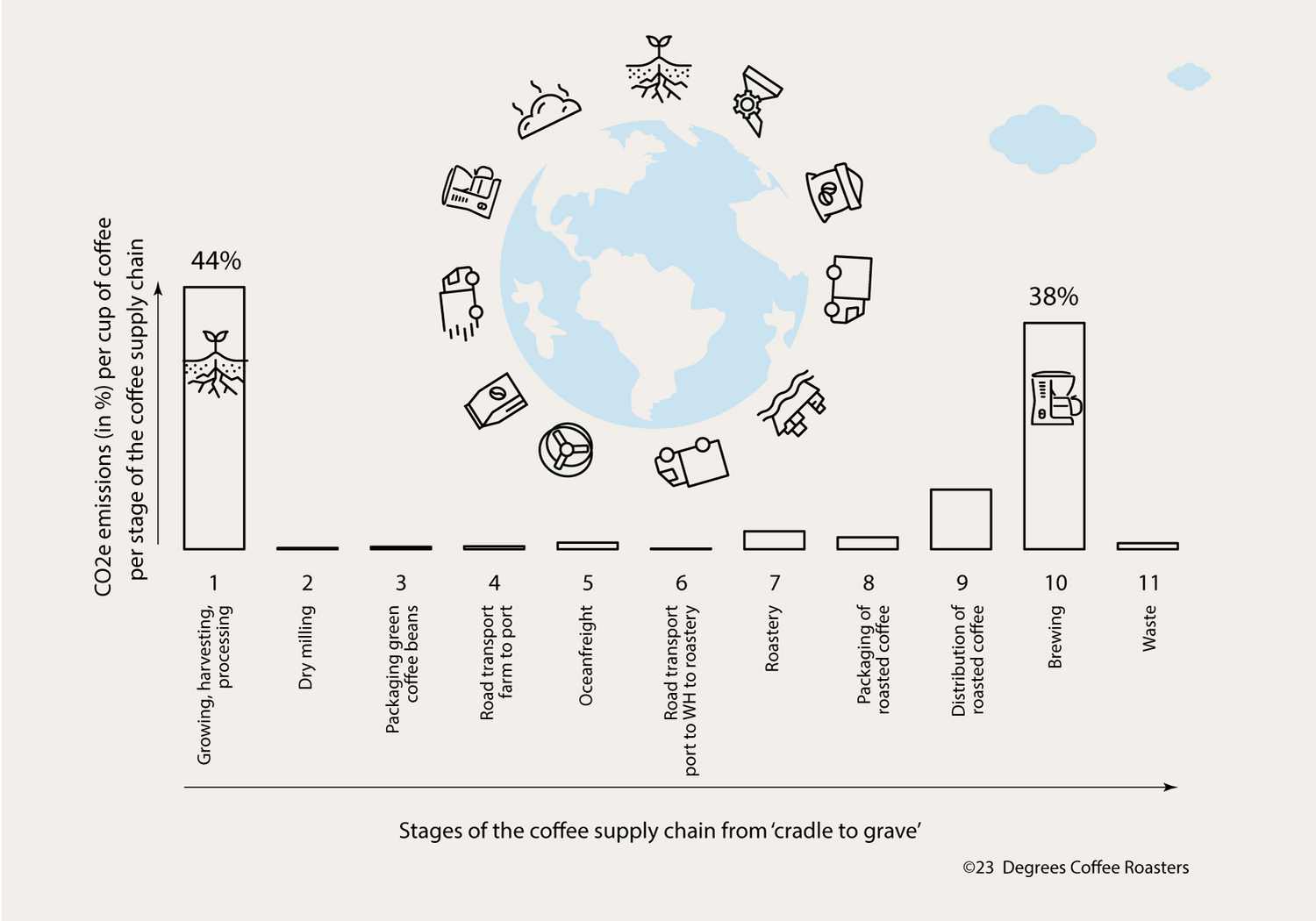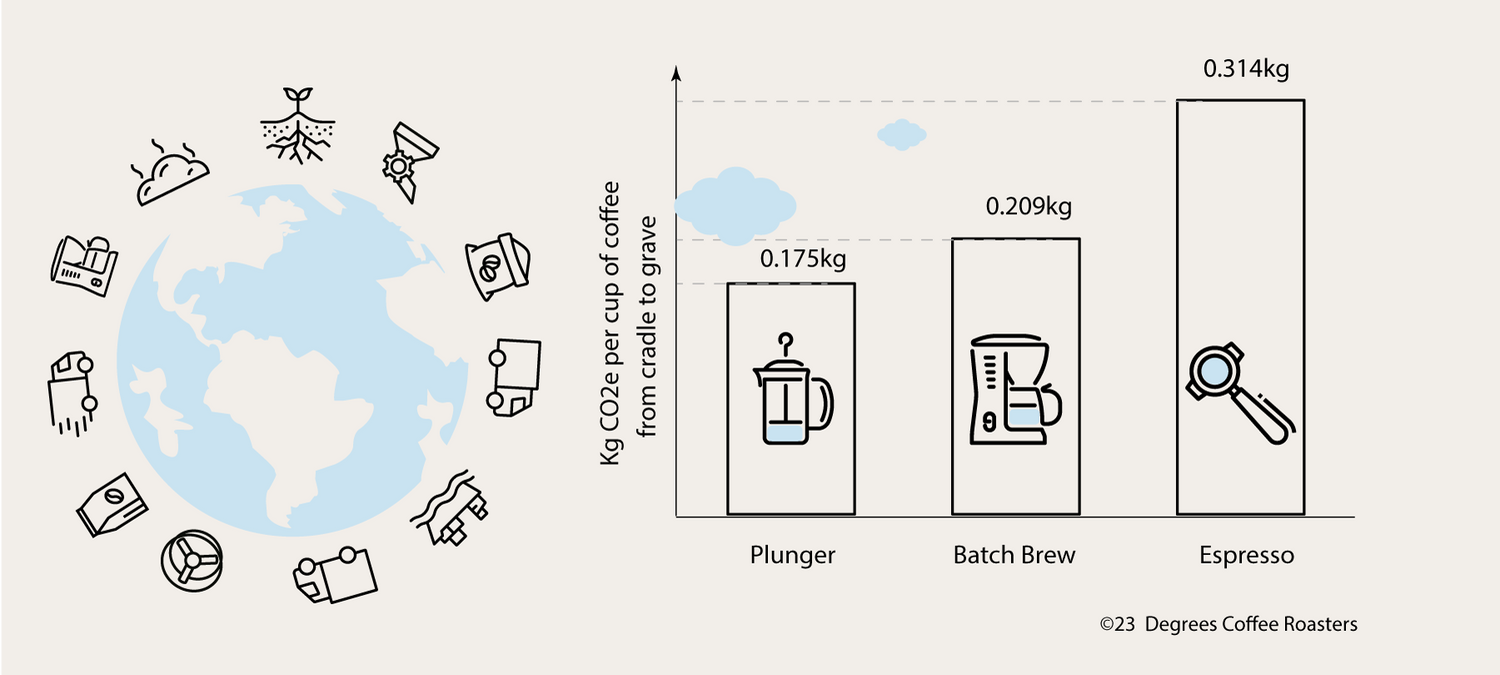The Carbon footprint of a cup of coffee
We wanted to understand the carbon emissions at each stage of our coffee supply chain to focus our carbon reduction initiatives on the areas of the most impact. We, therefore, undertook an extensive Life Cycle Assessment to estimate the carbon footprint at each stage of our coffee supply chain from ‘cradle to grave’. And the results took us by surprise.
The findings took us by surprise.
-
Activities and emissions within our operational control.
Surprisingly, only a tiny portion of the carbon footprint of a cup of coffee lies within our direct operational control (scopes 1 and 2 of carbon accounting). This includes transporting the green beans from the warehouse to our roastery, electricity and gas usage, and distribution activities.
Activities and emissions within our sourcing control.
The more significant portion of the carbon footprint is created in stages of the supply chain that are not under our operational control. However, by making better sourcing decisions, we can also directly impact greenhouse gas emissions in these stages.For example, 44% of the carbon footprint is generated at the farm level throughout the growing, harvesting and processing activities. Much of that footprint is due to the use of synthetic fertilisers and pesticides in conventional coffee cultivations.
Over the past years, we’ve purposefully extended our range of organic and wild-grown coffees, now representing 55% of all our coffees. These are coffees that were cultivated without the use of synthetic fertilisers and pesticides. So how is that impacting the carbon footprint of a cup of coffee? Good question. At the growing stage at the farm level, the emissions of organic cultivated coffees may reduce by up to 1/3. So moving to more organic coffees has the enormous potential to decrease the carbon footprint from the cradle to the grave.
We’ve also been working hard on our waste management strategy. To us, that means viewing waste as a resource that we aim to reuse, recycle or compost. 99% of the end of lifecycle waste is either reusable, recyclable or compostable.
-
Activities and emissions within your control.
The most surprising finding was that 38% of the CO2e emissions of a cup of coffee occur at the consumption stage by using energy for heating water for your brew.
When we modelled the carbon footprint of a cup of coffee, we had to make some assumptions. We assumed brewing a cup of batch brew using an automated coffee maker, 250ml of water and 17g of roasted coffee. Even within this brewing scenario, the outcome can vary based on the specific energy consumption of your coffee maker, your location and energy provider, the grind size and flow rate and whether you use the heat plate after brewing.
The carbon footprint of different brewing methods.
Based on your brewing method, the carbon footprint of your cup of coffee might be smaller or larger. Here are three popular brewing methods and their CO2e emissions:
- Batch brew: 17g of coffee, 250ml water, an automated coffee maker with 1450 watts, brewing time of 3 minutes
- Plunger coffee: 17g coffee, a water kettle with 1700 watts, time to boil 1.5 minutes
- Home espresso machine: 21g coffee, brewing two espressos, espresso machine with 1850 watts, 5 minutes warm-up time and 30 seconds brewing time.
What can you do to reduce the carbon footprint of your cup of coffee?
There are some easy changes in your daily coffee-making habit that can contribute to lowering the carbon footprint of your daily cup of coffee. Here they are:
- Don’t brew more coffee than you are going to drink. This not only avoids wasting coffee (and helps your pocket), it also saves energy when brewing water.
- Mix it up and grab some organic coffee beans.
- Avoid the use of disposable cups.
- Compost your coffee grounds or dispose of them in your green waste bin (subject to your local council regulations).
- Instead of leaving the warming plate of your coffee maker on, switch the coffee maker off and fill your coffee in a thermos to keep it warm.
- Place the coffee bags that are recyclable in the RedCycle bin for soft plastics.
You, as a consumer, can play a vital role in reducing the carbon footprint of a cup of coffee and in making coffee more sustainable.





